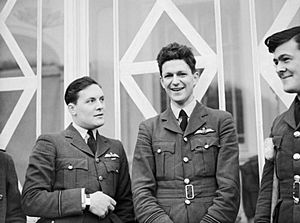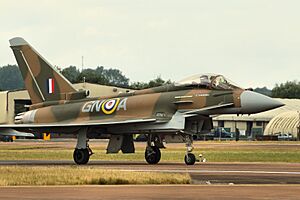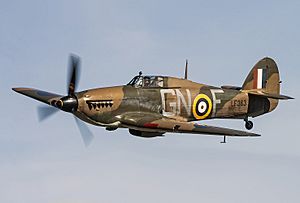James Brindley Nicolson facts for kids
Quick facts for kids
James Brindley Nicolson
|
|
|---|---|

Flight Lieutenant Nicolson (centre) while recuperating from wounds after his VC action, November 1940
|
|
| Born | 29 April 1917 Hampstead, London |
| Died | 2 May 1945 (aged 28) Bay of Bengal |
| Allegiance | United Kingdom |
| Service/ |
Royal Air Force |
| Years of service | 1936–1945 |
| Rank | Wing Commander |
| Service number | 39329 |
| Unit | No. 72 Squadron No. 249 Squadron |
| Commands held | No. 27 Squadron |
| Battles/wars | Second World War
|
| Awards | Victoria Cross Distinguished Flying Cross |
James Brindley Eric Nicolson (born April 29, 1917 – died May 2, 1945) was a brave fighter pilot and leader in the Royal Air Force during World War Two. He received the Victoria Cross, which is the highest award for bravery given to British and Commonwealth soldiers. He earned this award in August 1940 for his amazing actions during the Battle of Britain.
Early Life of James Nicolson
James Brindley Eric Nicolson was born in Hampstead, London, on April 29, 1917. He went to school at Yardley Court and Tonbridge School. In 1935, Nicolson started working as an engineer at Ricardo Engines. A year later, in 1936, he joined the Royal Air Force (RAF). After his training, he joined No. 72 Squadron in 1937. Later, in 1940, he moved to No. 249 Squadron.
Bravery in World War Two
Nicolson was 23 years old and a flight lieutenant in No. 249 Squadron when he earned the Victoria Cross. This happened during World War Two. On August 16, 1940, he took off from RAF Boscombe Down near Salisbury.
During a flight, Nicolson's Hawker Hurricane plane was attacked. It was likely hit by a German Messerschmitt Bf 109. His engine was damaged, and his fuel tank caught fire. As he tried to escape his burning plane, he saw another enemy Messerschmitt.
Despite the danger, he got back into his seat. He pressed the firing button and kept shooting until the enemy plane crashed. Only then did he bail out of his own plane. He managed to open his parachute in time and landed safely in a field. As he came down, members of the Home Guard fired at him. They did not realize he was an RAF pilot, even though he shouted to them.
Remembering a Hero

In 2015, the RAF honored Nicolson. They repainted a modern Eurofighter Typhoon jet, named ZK349, in World War Two colors. They also added Nicolson's squadron number, GN-A, to the jet. This was done to mark the 75th anniversary of the Battle of Britain.


